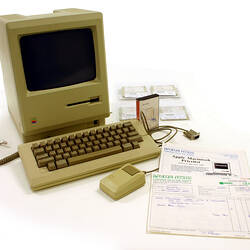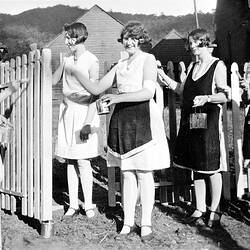Summary
MacDraw was a drawing and layout tool developed by Apple computer Inc that took advantage of the Macintosh's new graphical user interface, whose innovative nature was exemplified by MacDraw.
With the MacDraw application, Apple showed how graphics software could work with a paper-like white screen, mouse and 'what you see is what you get' printing. (WYSIWYG = What You See Is What You Get).
MacDraw was a vector graphics program, that is, a program that stored images as mathematical descriptions and displayed them as objects which could be edited to change their size, shape and position. This was a large improvement on programs such as MacPaint, which used pixels, and saved drawings as bitmaps only, where images, which consisted of 'on' and 'off' pixels, which once created, could not be re-sized or re-shaped and could only be repositioned by using 'cut' after selecting all the pixels that comprised the 'image' and pasting them in a new location.
An object in MacDraw could be selected, copied and pasted into MacWrite. MacDraw was a significant part of the beginning of the 'DeskTop Publishing' (DTP) revolution as its objects could be placed in a file created using DTP software such as PageMaker. On screen, bitmaps and vector graphics looked much the same. The significance was in the jump from dot matrix printing to the laser printing associated with DTP. At 72dpi a bitmap looked almost acceptable when printed on a dot matrix printer of roughly double that resolution, but with 300 dpi available on the LaserWriter, bitmaps looked jagged. By comparison, the vector graphics printed smoothly at 300 dpi, setting a new standard of presentation at a time when the PC world could barely output text, let alone dream of graphics output.
The capabilities of MacDraw were amazing at the time, especially its ability to edit and reprint a drawing in a way that is not possible with manual drawing. MacDraw was especially useful for drawing technical diagrams and floor plans.
The technical drawing capability of MacDraw was further developed in Claris CAD (Computer Aided Design), which clearly shows its MacDraw origins with many CAD enhancements. MacDraw continued to live on in a cut down form in ClarisWorks, which was subsequently re-named AppleWorks.
The donor, a lawyer, states that his favourite use of MacDraw is to create quick and dirty technical drawings. He said that it was no quicker to create simple drawings on computer than with pen and paper; the advantage was in being able to edit and reprint a drawing in a way that was not possible with manual drawing.
Another user of MacDraw, in his occupation as an optometrist specialising in contact lenses, used Mac Draw and spreadsheets for the analysis of data in the design and construction of contact lenses. MacDraw was particularly useful in the construction of concentric curves to satisfy the fitting of corneas with various characteristics.
Although primitive drawing and a mouse became available on late models of the Apple II, it was clumsy when compared to the 72 dots per inch on the Macintosh, albeit at first in black and white, but then subsequently in greyscale and later in colour.
Part of a representative collection of hardware, software, trade literature and promotional material that documents the history of the Apple company, and its contribution to, and impact on the computer industry and society.
Physical Description
This software package contains a box with one manual, two disks, a cassette tape in crystal case and an update document. The manual has notes from the upgrade document taped in to the inside cover and addendum notes taped over the relevant paragraphs of the manual. This is indicative how the user was involved in the documentation and use of the manual. Cardboard box containing two 3 1/2 inch disks and tape in blow moulded packing 1. Label: "MacDraw" 2. Label: "MacDraw A Guided Tour" One compact cassette tape " A Guided Tour of MacDraw". "MacDraw" manual Spiral bound 120 pages "Macintosh Update MacDraw " seven page A4 set of pages stapled
More Information
-
Collection Names
The Apple Company Collection, Internet Macintosh User Group (iMug) Collection
-
Collecting Areas
-
Acquisition Information
Donation from John Green, 22 Nov 2007
-
Manufacturer
Apple Computer Inc, Cupertino, California, United States of America, 1984
-
Format
Magnetic carrier, Floppy disk, 3.5 inch
-
Inscriptions
MacDraw
-
Brand Names
-
Classification
-
Category
-
Discipline
-
Type of item
-
Overall Dimensions
250 mm (Length), 210 mm (Width), 50 mm (Height)
-
Keywords
Computer Aided Design (CAD), Computer Aided Drafting (CAD), Computer Graphics, Computer Software, Computers, Computing, Drafting, Drawing Materials, Innovation & Design




